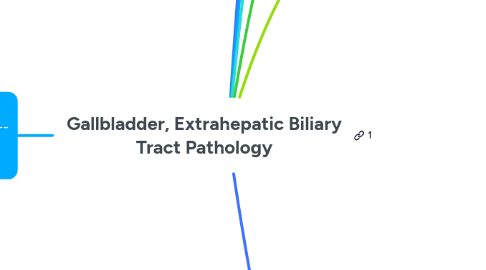
1. **Cholecystitis**: ----------------------------------------- Gallbladder Inflammation from **stones** or **ischemia**
1.1. Calculous Cholecystitis (90%) **Acalculous Cholecystitis: Cystic Artery Ischemia** - *What are the findings of Acute vs. Chronic calculous cholecystitis*?
1.2. Signs and Symptoms
1.2.1. Nausea, Vomiting
1.2.2. RUQ epigastric pain > 6 hours
1.2.3. Murphy's Sign
1.2.3.1. Positive Murphy's Sign
1.2.4. Mild fever, leukocytosis
1.2.5. What are the **Histological** differences between **Acute** and **Chronic** Cholecystitis?
1.2.5.1. **Acute: Presence of Neutrophils** *How does this relate to the gross appearance of a gallbladder experiencing acute inflammation? *
1.2.5.2. **Chronic: Rokitansky-Aschoff sinuses** - *Outpouching of mucosal glands protruding through the muscular layer of the gallbladder wall * - *Chronic inflammation and fibrosis *
1.3. Complications
1.3.1. choledocholithiasis
1.3.2. cholangitis
1.3.3. :arrow_left: Perforation
1.3.3.1. Peritonitis, sepsis, Abscess
1.3.4. Fistula / Gallstone Ileus
1.3.4.1. Gallstone Ileus
2. Normal anatomy of the Gallbladder and Biliary tract
2.1. Galllbladder Histology
2.2. Gallbladder Histology
3. Congenital Anomalies
3.1. Define / Distinguish biliary atresia, types, pathogenesis, and corrective surgical procedures
3.1.1. Choledochal cysts
3.1.1.1. congenital cystic dilatations or diverticula of bile ducts - biliary obstruction
3.1.2. Biliary Atresia
3.1.2.1. Corrective Surgery
3.1.2.1.1. Kasai Procedure
3.1.2.2. Forms of Biliary Atresia (2)
3.1.2.2.1. Fetal Form 20%
3.1.2.2.2. Perinatal form (MOST COMMON)
3.1.2.2.3. Epidemiology
3.1.2.3. complete or partial obstruction of biliary tree
4. **Cholelithiasis**: ----------------------------------------- Stones in the gallbladder. Most: **Asymptomatic**. **Symptomatic:** :arrow_right: *Uncomplicated * - or - :arrow_right: *Complicated * - *How common is it? * - *What is Symptomatic? *
4.1. What are the stones made of? *Cholesterol* vs *Pigmented* Stones
4.1.1. Cholesterol stones 80% - Cholesterol - Yellow/Green/Gray Coloring
4.1.2. Pigmented stones - Calcium Bilirubinate - Brown or Jet Black
4.2. **Pathogenesis of Gallstones**: - *What keeps stones from forming in normal bile? * - *What changes in the gallbladder / its internal environment promote stone formation? *
4.2.1. 1. supersaturation of bile with cholesterol 2. Hypomotility of gallbladder 3. Excess mucus secretion in the gallbladder.
4.3. **Imaging**: *What determines whether or not gallstones show up on X-Ray? *
4.3.1. Radiopaque Gallstones / Cholelithiasis These stones have :arrow_up: [ Ca2+ ]
4.4. Risk Factors for Gallstones
4.4.1. **Cholesterol Stones** - *What role does Estrogen play underlying some of the common risk factors? *
4.4.1.1. Five Fs
4.4.1.1.1. Female
4.4.1.1.2. Fertile - 1+ children
4.4.1.1.3. Fair - Caucasian
4.4.1.1.4. Forty - > 40 yo
4.4.1.1.5. Fat - BMI > 30
4.4.1.2. **Genetic Risk Factor**: *ABCG8 Gene *
4.4.2. **Pigmented stones** - *What is the common underlying theme between disorders that predispose to pigmented stones? *
4.4.2.1. **Disorders a/w elevated unconjugated bilirubin:** 1. Hemolytic Anemias 2. Bacterial Colonization of Biliary Tree (*by who?*) 3. Parasitic Colonization of Biliary Tree (*by who?*)
5. **Choledocholithiaisis**: --------------------------------- Gallstones within the **Common Bile Duct**
5.1. Obstruction May Cause:
5.1.1. 2° biliary cirrhosis
5.1.2. pancreatitis
5.1.3. Jaundice
5.1.4. cholangitis
5.1.5. Pain
6. **Cholangitis**: ------------------------- Inflammation of the **Biliary Tree**
6.1. Result of **bacterial infection** ascending from duodenal junction, predisposed by obstruction of the duct.
6.1.1. Choledocholithiasis
6.2. Clinical Findings
6.2.1. Charcot's Triad
6.2.1.1. RUQ pain
6.2.1.2. Fever, Chills
6.2.1.3. Jaundice / Hyperbilirubinemia
6.2.2. Reynold's Pentad
6.2.2.1. Musculoskeletal changes and Sepsis on top of Charcot's Triad
6.3. Complications
6.3.1. Medical Emergency
6.3.1.1. Prompt ABX therapy
6.3.1.2. Endoscopic biliary drainage
6.3.1.3. Surgical evaluation
6.3.2. Hepatic abscesses
6.3.3. Sepsis
7. Neoplasms of Gallbladder and Extrahepatic biliary tract
7.1. Gallbladder Adenomas
7.1.1. Rare
7.1.2. Similar to
7.1.2.1. Adenomas of the colon
7.1.3. Malignancy Potential
7.1.4. Histology
7.1.4.1. Nuclei
7.1.4.1.1. hyperchromatic (dark)
7.1.4.1.2. elongated
7.2. Gallbladder Carcinomas
7.2.1. Rare
7.2.2. Adenocarcinomas, Mostly
7.2.2.1. Malignant glands invading the wall of the gallbladder
7.2.3. Prognosis
7.2.3.1. Very Poor
7.2.4. Risk factors
7.2.4.1. STRONGEST RISK FACTOR
7.2.4.1.1. Gallstones
7.2.4.2. Others
7.2.4.2.1. Obesity
7.2.4.2.2. Female sex, multiparity
7.2.4.2.3. Old age
7.2.4.2.4. Native Americans, Hispanics, Korean, Chinese
7.2.4.2.5. Chronic bacterial and parasitic infections
7.3. Carcinomas of the extrahepatic bile ducts
7.3.1. Adenocarcinomas, Mostly
7.3.2. M > F
7.3.3. Associated with
7.3.3.1. Primary Sclerosing Cholangitis
7.3.3.2. IBD
7.3.3.3. Choledochal cysts
7.3.3.4. Trematodes
7.3.4. Signs
7.3.4.1. Courvoisier's Sign
7.3.4.1.1. In the presence of jaundice, a painless, palpable gallbladder is unlikely to be due to gallstones
7.3.5. Most aren't resectable
7.3.5.1. short survival
7.3.6. Klatskin Tumor
7.3.6.1. Tumor located at juntion of right and left hepatic ducts
